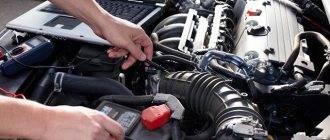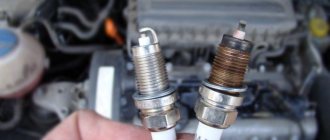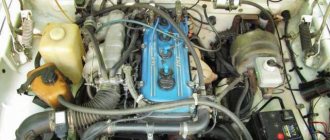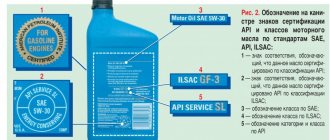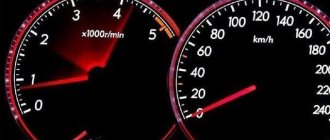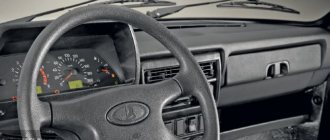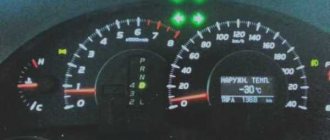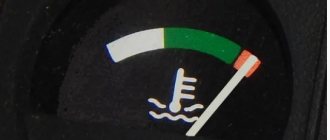At one time it takes a long time to start, but then it starts with difficulty, and at another time it may start the first time and immediately stall. What could be the reason for this behavior? There is no difference, what, what.
Such a problem as: the engine stalling at idle speed can be heard quite often. And even if after some period of time the engine does start, the cause of the malfunction will have to be looked for one way or another. And the sooner the better, because there may be several of them.
The following two tabs change content below.
All my life I have been surrounded by cars! First, in the village, already in the first grade, I was rushing around on a tractor through the fields, then there was JAVA, then a penny. Now I am a third-year student at the Polytechnic Faculty of Automotive Engineering. I work part-time as a car mechanic and help repair cars for all my friends.
The video below shows an example when a VAZ-2112 stalls at idle:
Reasons why the engine stalls
Location of the throttle valve on a VAZ-2112 - photo of an editorial car
Stalls at idle, why?
Such a problem as: the engine stalling at idle speed can be heard quite often. And even if after some period of time the engine does start, the cause of the malfunction will have to be looked for one way or another. And the sooner the better, because there may be several of them.
The following two tabs change content below.
- About the expert:
All my life I have been surrounded by cars! First, in the village, already in the first grade, I was rushing around on a tractor through the fields, then there was JAVA, then a penny. Now I am a third-year student at the Polytechnic Faculty of Automotive Engineering. I work part-time as a car mechanic and help repair cars for all my friends.
The video below shows an example when a VAZ-2112 stalls at idle:
Reasons why the engine stalls
In all cases when the engine is unable to maintain idle speed, the malfunction is associated with contamination or failure of any part. The most basic elements to pay attention to:
- Clogged or broken idle air regulator.
IAC on VAZ-2112 - Carbon deposits or contamination of the throttle valve and injector channels require cleaning and diagnostics.
Cleaning the throttle valve from dirt - The presence of significant deposits in the fuel supply system and fuel pump, as well as the grid.
- Failure of the mass air flow sensor.
- The engine crankcase ventilation system is dirty.
Location of the throttle valve on a VAZ-2112 - photo of an editorial car
Idle speed sensor VAZ 2110 (IAC): repair and replacement
General concepts
One of the most common troubles that prevents you from fully driving a car is the idle speed sensor of the VAZ 2110 and modifications.
Although this device is called a sensor among drivers, it will still be correctly called the idle speed controller, abbreviated as IAC, because all automobile sensors are measuring equipment, and this product serves to automatically stabilize and maintain idle speed by supplying air to the engine VAZ 2110 with the throttle valve fully closed. IAC is an important component of the engine and plays a significant role in the stable and uninterrupted operation of any VAZ vehicle.
Idle speed control
The VAZ 2110 idle speed sensor (abbreviated DXX) is an actuator, simply a valve consisting of an electric motor, a spring, and a rod on which a shut-off needle is installed (you can see it in the photo). It is through which the volume of air is dosed. That is, when the throttle of a VAZ 2110, 2112 is completely closed, and the controller determines that the idle speed needs to be increased, the IAC generates a command to change the position of the needle. It moves, partially or completely opening the intake port, through which air bypasses the throttle and then mixes with fuel. As a result, the engine does not stall.
The car starts and stalls immediately after the starter is turned off.
- When a car stalls at idle, the reason for this is that the throttle valve is dirty; it becomes clogged and sticks. This problem is solved by cleaning, using a carburetor cleaner from a bottle. Reason: low-quality fuel and large contaminants entering through the air filter.
- Contamination in the oil trap system in the engine crankcase.
Malfunctions in the air mixture supply system
Here the problem lies either in a clogged air filter or in the failure of the regulator responsible for idling the car. In this case, your car will stall all the time when you gain speed or when you release the gas when you release the accelerator.
To solve the problem, remove and inspect the air filter. If there is serious contamination or chips, replace it. To diagnose and replace the idle speed regulator, you will need the help of qualified car service employees.
Signs of IAC malfunction
Unfortunately, the 2110 VAZ DXX is not equipped with a self-diagnosis system, so the “CHECK ENGINE” light signal will not indicate a malfunction. Loss of performance on the VAZ 2110, 2112 is determined by the following main features:
- the engine “stalls”, for no apparent reason, at idle;
- idle speed “floats”;
- when a “cold” VAZ 2110, 2112 engine is started, there is no increased speed at all;
- The engine stalls, namely, after turning off the gear while driving.
The symptoms completely coincide with the failure of the VAZ 2110 TPS, but in the case of this sensor the “CHECK ENGINE” indicator will light up.
What could have broken?
If the machine does not work, it means the motor is broken. This can often be heard from an inexperienced driver. But in a car, in addition to the engine, there are many different elements, on the serviceability of which the operation of the power unit depends. If the car is not completely “dead” and when the starter rotates it shows signs of life, “sneezes” or “shoots” into the exhaust pipe, the fault will be more difficult to find.
The malfunction that led to the engine shutdown is hidden in one of the three systems of the VAZ 2112:
- electrical equipment and power supply;
- fuel supply system;
- gas distribution mechanism and piston group.
You must understand that if the level of coolant or oil in the crankcase is low, the engine will not stall; it may fail due to overheating or lack of lubrication. Therefore, it is important to recall the circumstances preceding engine failure. It’s one thing when the power unit just stopped moving, another thing if before that you heard extraneous knocks or shots in the exhaust. In the first case, the electrical part is probably to blame.
A sign of the second situation is often a broken timing belt, which is easy to detect by removing its upper plastic casing. The belt can be changed on the way if you have a spare one, otherwise you will have to look for a part or a towing company. If the starter cannot crank the engine when trying to start, there may be two reasons:
- there was a breakdown in the generator circuit, and the voltage source was the battery, which as a result was discharged;
- the crankshaft jammed due to lack of lubrication.
In both situations, you need to find a way to deliver the car for repairs; you won’t be able to do anything on the road.
Causes:
- malfunction of the idle speed sensor;
- throttle valve clogged;
- malfunction of the throttle position sensor;
- contamination of the injector or carburetor
The reasons for the breakdown can be completely different, so when eliminating them you will have to operate with all sorts of actions.
You need to be able to get your car working without outside help. If your level of awareness or lack of free time does not give you the opportunity to eliminate all the defects yourself, it is better to seek help from knowledgeable people who can save you from unpleasant moments in the shortest possible time.
Where are the IAC and TPS sensors located?
So, first, let's check the IAC sensor. It is located on the throttle assembly below the TPS sensor. Dismantling it is very simple - remove the block from the sensor and use a Phillips screwdriver to unscrew the two bolts securing it. Then we pull out the sensor or perform diagnostics on it, read about this below.
The throttle position sensor is located above the IAC and is also secured with two bolts. It unscrews quite easily; there is no need to remove either the pipe or the throttle itself. Disconnect the block, unscrew the two bolts and pull out the sensor.
To make sure that the problem with high speed is really in one of these sensors, and maybe in each other at once, you should diagnose them.
Signs and solutions to problems
Below we will look at the most common signs when a car stalls at idle.
The car starts and stalls immediately after the starter is turned off.
- When a car suddenly stalls at idle, the most common reason is that the throttle valve is dirty, causing it to become clogged and sticky. This problem is solved by simply cleaning it, using a carburetor cleaner from a bottle. This happens due to the use of low-quality fuel and the presence of large contaminants entering through the air filter (for example, oil).
This is what a dirty damper looks like. - It is also worth paying attention to the presence of contaminants in the oil trap system in the engine crankcase. Because if this filter is dirty, the engine will simply stall from excess crankcase gases.
The car starts and immediately stalls
Checking the MAF sensor readings
The cause of a malfunction with such symptoms is most often the above-mentioned sensors: IAC (idle air control), MAF (mass air flow sensor). Before purchasing new parts, you need to disassemble them and check for contamination. Also check the mass air flow sensor for the main signs of malfunction. However, if you have the opportunity to check the malfunction using diagnostic equipment, then do not deny yourself this. Read more about replacing the IAC here, and about replacing the mass air flow sensor here.
The functionality of all sensors should be checked in order, starting from the least structurally complex to the most.
Results and conclusions
If all the above reasons do not help you, you have a chance to seek help for a professional diagnosis. Since the “check engine” pops up, it will still indicate the cause of the malfunction and it will take a lot to replace this element.
If somewhere along the way your VAZ 2112 stalls, starts up briefly, and then turns off again, then it is unlikely that you will be able to fix the problem in the field. Although there are no rules without exceptions, it happens that the tank simply runs out of fuel, and the sensor is lying. But oddly enough, it is much easier to detect a breakdown in a car when it shows no signs of life. Whether it will be possible to revive him on the road is a difficult question, but it’s worth a try. There are several recommendations.
Electrical faults
There are several reasons why the engine may stall:
- ignition switch malfunction;
- the fuse in the fuel pump circuit has burned out;
- no voltage is supplied to the spark plugs;
- one of the sensors on which the operation of the power unit depends has failed.
First of all, it is recommended to check the operation of the fuel pump; when the ignition is turned on, it emits a quiet hum (coming from the rear of the car). When there is no such sound, it is necessary to open the VAZ 2112 fuse box and check the condition of fusible link No. 3, which closes the fuel supply relay circuit. The blown fuse must be replaced with a new or temporary “bug” made of copper wire and try to start the engine. If the car starts, feel free to continue on your way.
Without knowledge of the electrical part of the car, a breakdown of the ignition switch cannot be avoided, and it is not easy to diagnose it. Therefore, it is recommended to check for a spark on the spark plugs, for which you need to unscrew one of them and securely attach it to a metal part of the engine by connecting a high-voltage wire. Then turn on the starter and watch for sparking. If there is a spark, good, we need to look in a different direction. If it is not present, the following breakdowns may occur:
- the simplest thing is failure of high-voltage wires or spark plugs;
- malfunction of the ignition switch or the corresponding relay;
- the switch or ignition distributor slider has become unusable (on carburetor cars);
- The crankshaft position sensor has failed (on cars with an injector).
If high-voltage wires or spark plugs can be replaced, then the breakdown of other elements must first be accurately diagnosed, which is hardly possible in the middle of a field. In addition, the throttle position or air flow sensor may break, causing the controller to switch the injector to emergency mode. Then the car may often stall at idle.
Diagnostics of TPS VAZ 2110
To diagnose the sensor we need a voltmeter.
- It is necessary to turn on the ignition and check the voltage between the slider contact and the minus with a voltmeter. The voltmeter should read no more than 0.7 V.
- Now you need to turn the plastic sector, thereby completely opening the damper, then measure the voltage again. The device must show at least 4 V.
- Turn off the ignition and disconnect the connector from the sensor. We check the resistance between the slider contact and some terminal.
- Slowly, turning the sector, monitor the voltmeter readings. Make sure that the needle moves smoothly and slowly; if you notice jumps, the throttle position sensor is faulty and must be replaced.
Symptoms of TPS malfunction
- Deterioration of vehicle dynamics
- Floating idle speed
- Jerking during acceleration
- High idle speed, car does not slow down
- The engine may stall at idle
If one or more of these symptoms are detected, the sensor should be checked and diagnosed in the manner described above.
What to do if cars with automatic transmission stall?
If your vehicle has an automatic transmission, then the problem should be found in the electrical supply. If you abruptly switch from one gear to another, or while switching gears while braking, the settings may be distorted, and the on-board computer will receive a signal to turn off the engine.
Also, models with automatic transmission may stall due to malfunctions of the hydrodynamic transformers of the gearbox. This problem mainly manifests itself during acceleration and requires urgent intervention from car service specialists.
How to troubleshoot
It is best to contact a service center. This will allow you to quickly identify and fix the problem, but you will have to pay for the services of a specialist. Work that can be carried out at the auto center:
- complete replacement of equipment that has become unusable;
- regeneration of failed devices;
- carrying out preventive procedures and bringing equipment into proper condition
The optimal solution is a complete replacement of non-working equipment. You can also install a new idle speed sensor, throttle valve, throttle position sensor, injector or carburetor
IAC cleaning
It is recommended to wash and clean any non-working idle speed sensor on the VAZ 2110 to make sure it is faulty. The process is very simple and will not take much time. To do the job you need: carburetor cleaner, WD-40. The following actions are performed:
- The block is removed from the sensor;
- Apply any of the listed cleaning liquids to a regular cotton swab and carefully treat the contacts;
- Unscrew the screws securing the idle speed sensor;
- Remove the IAC from the seat;
- Inspect the idle speed sensor. If black dirt, oil, or IAC are detected, it is necessary to clean the entire throttle assembly. If not, spray WD-40 or cleaner onto the needle with a spring, thereby cleaning it. Dry the idle speed sensor VAZ 2110, 2112;
- Before reinstalling, measure the distance between the idle speed sensor housing and its needle, which on a working regulator is 23 mm.
When the IAC VAZ of the tenth family did not work normally, the guide needles wore out and the wire inside the housing broke. In these cases, the idle air regulator must be replaced.
On a VAZ 2110, the idle speed sensor is mounted in the reverse order of dismantling.
Functionality check
We have already talked about where the sensor is located. The first thing you need to do is find it and remove the block with wires. On a VAZ 2110, you must first unscrew the fastening elements of the throttle assembly, then move the entire assembly by about 10 mm.
Check with a voltmeter that the voltage is appropriate to the sensor. To do this, you must first connect the negative terminal of the battery to ground and connect a voltmeter to terminals A and D (they are usually marked), then:
- If the voltmeter shows less than 12V, this most likely indicates that the battery is not charged;
- If nothing is shown, faults should be looked for in the electronic control unit or in the circuit;
- If the reading is 12V or more, you need to check the regulator directly, or more precisely, its resistance;
- We connect a tester to the four terminals, which should give a total resistance reading of 50 or 55 Ohms.
Testing in pairs should give an infinitely large resistance. If the idle speed sensor on a VAZ 2110 (injector) gives different readings, it means it needs replacement.
You can also test the regulator in another way: remove the sensor and connect the block. Pressing the needle with your finger, watch its extension. When the ignition is turned off, there should be a push of the needle.
If everything is normal, then usually the speed does not fluctuate and the sensor itself is in working condition. If there is no shock, you can try cleaning the mechanism.
This is done using a special cleaner called WD-40. They very carefully, using a cotton swab, clean everything that is possible in the sensor.
Particularly carefully - the rod, as well as the needle. But if this does not help, a replacement is needed.
How to check the sensor?
If you have a tester, checking is easy:
- Set the VAZ 2110 to the handbrake;
- Disconnect the IAC connector to check;
- Check the voltage of the VAZ 2110, 2112 sensor circuit, while connecting the “minus” to the engine, the “plus” to the removed block, namely to terminals A: D (marked on the block, you can see the diagrams);
- The ignition is turned on and the readings given by the idle speed regulator are checked, which should be about 12 V. The value will be less - most likely the battery is discharged. When there is no voltage, it is necessary to check the entire circuit, and then the electronic control unit. There are no malfunctions, which means the circuit is working - the IAC installed on VAZ 2112 engines and other modifications are checked;
- The tester terminals are connected to the block, the circuit is as follows - first to terminals A: B, then to C: D. The resistance should be within 53 Ohms;
- Next, pairs A: C, B: D are checked - in this case, the resistance on a working product will be infinitely large.
IAC diagram
When, as a result of these checks, the sensor reveals a discrepancy in the readings, it should be replaced. Also, the inoperative state of these VAZ 2110, 2112 engine sensors, in the unscrewed position, can be checked by attaching a block to them, then you need to turn on the ignition.
When the power is connected to the working product, the rod with the needle will change position. No changes will occur on a broken sensor. If a breakdown of the idle air regulator is detected, of course, it must be repaired. But there is no need to rush to a car service center - you can do the repairs yourself, saving money and time. But first, in general, it is worth cleaning the IACs; often after this they return to “life”.
Fuel supply problems
The reason that the engine stalls at idle may be not only the fuel pump, but also a fuel filter that has not been changed for a long time.
If the element is completely clogged, then the amount of fuel passing through it is simply not enough for the normal operation of the power unit.
In carburetor VAZ 2112 models, the cause of a lack of fuel may be wear of the mechanical drive of the fuel pump or its diaphragms. It's easy to check: disconnect the fuel supply hose from the carburetor and direct it into a plastic bottle, then turn on the starter. The stream of gasoline from the hose should be powerful and steady; when gasoline flows weakly, try temporarily removing the gasket under the mounting flange of the fuel pump.
The lack of fuel in the carburetor is checked by removing the air filter cover and pressing the accelerator rod. A stream of fuel should spray from the nozzle nozzle exiting into the primary chamber of the carburetor. When it is not there, you need to clean the strainer installed at the inlet of the unit, or check the operation of the needle valve.
As for the injector, it is unrealistic to detect faults with the fuel supply on the road. Even if you manage to get to the injectors and unscrew them, you will not be able to check. In order for the injector to supply fuel, it must receive a signal from the controller. Only an experienced electrician can create such a signal artificially, so disassembling the injector on the way does not make sense. It will be difficult to find the reason for the lack of a spark, which may be hidden in the ignition module or in the coil. You can find out more precisely only at a car service center.
content .. 37 38 39 40 ..Lada VAZ-2110 (2111, 2112). Lost engine idling (possible reasons)
Before identifying a malfunction, it is necessary to carry out a visual inspection of the engine compartment (elements of the ignition system, sensors, tubes, hoses), check the tightness of the contacts in the connecting blocks, the tips of high-voltage wires in the ignition coil and spark plugs. Causes of unstable idling of an injection engine related to the ignition system
— Spark plugs are faulty
Faulty spark plugs: flooded after an unsuccessful start, the insulator is “broken,” the gap between the electrodes does not correspond to the norm (0.9 – 1.1 mm), the spark plugs do not match the engine’s heat rating. External signs: unstable idling, uneven exhaust from the muffler (periodic or frequent misfires). It is necessary to blow out the spark plugs: press the gas pedal all the way down and crank the engine with the starter for several seconds (the so-called purge mode). Having turned them out, evaluate the condition of the contacts, the presence and color of carbon deposits, and check the gap with a round feeler gauge. Non-working spark plugs are often clogged with carbon deposits or wet. But in some cases it is impossible to determine their malfunction visually, so the easiest way is to install a new kit and check the engine idling again.
— High-voltage wires are “broken”
External signs are similar to candlesticks. You can check the serviceability of the wires with a tester in ohmmeter mode. You can start the engine in the dark and observe the glow on the “broken” wires. In addition, it is necessary to visually verify the integrity of the wires and their tips, the absence of dirt and cracks on them. — The ignition coil (module) is faulty
First, we inspect the coil: check for cracks and damage. Then we check it with a tester in ohmmeter mode (See “Checking the ignition module”). We replace the one that does not pass the test with a serviceable one.
Malfunctions related to the engine control system (ECM)
— Idle speed regulator (sensor) (IAC) is faulty
The rod of a faulty regulator may not timely close the air supply channel necessary for engine operation at idle under the throttle valve. Signs of a faulty regulator, in addition to unstable idling: starting the engine by pressing the gas pedal, jerks and drops in speed when changing gears and coasting, “floating” speed, idling sometimes, sometimes not, drop in speed when powerful electrical consumers are turned on. At the same time, in other modes with the gas pedal pressed, the engine can operate normally without failures, jerking or jerking. The sensor can be checked with a tester or replaced with a known good one (by adjusting the protrusion of its needle).
— Throttle position sensor (TPS) is faulty
A faulty TPS may provide the control unit with incorrect information about the throttle position. As a result, at idle speed the engine speed may increase greatly and be reluctant to decrease to normal or not decrease at all. The TPS can be checked with a tester or replaced with a working one.
— The throttle valve does not close tightly
It is necessary to check the tightness of the air damper by removing the air filter housing. By pressing the gas pedal several times, check the smooth operation of the damper drive and its opening and closing. If there is carbon deposits in the throttle assembly that prevents the valve from closing tightly, remove it, for example, with carburetor cleaner.
— The coolant temperature sensor (DTOZH) is faulty
Based on the sensor readings, the control unit determines the amount and duration of injection, how far to move the IAC rod and open air access to the engine. If the DTOZH is faulty, then, for example, in cold weather the unit will not allow you to greatly enrich the mixture at start-up and at idle (the engine either will not start, or will start, but will “triple”). But in the heat, on the contrary, give a rich mixture and the idle speed will go through the roof.
— Speed sensor (DS) is faulty
Signs: after stopping the car, the engine runs unevenly, then the speed stabilizes, the speed drops when changing gears and coasting.
— The oxygen concentration sensor (OC) is faulty
The sensor's sensitive element may have failed (for example, due to the use of low-quality fuel, the use of inappropriate sealants during engine repairs), the heating coil has burned out, or the electrical circuit is faulty. The air intake hole in the sensor may be clogged (with dirt, anticorrosive). You can preliminarily check the sensor with a tester without dismantling it, but checking it with diagnostic equipment is advisable.
— “Suction” of foreign air into the intake tract
Check the tightness of the hoses going to the throttle assembly and to the vacuum brake booster, and the fastening of the clamps. The vacuum hose can be pinched to prevent it from affecting engine operation.
— The valve clearances are not adjusted
Check and adjust the clearances in the valve mechanism using washers.
- Worn camshaft cams
Can be determined visually or by checking with a micrometer.
— Disturbed valve timing
The timing belt has jumped a tooth or two. Or, during repairs, the marks on the pulleys are set with deviation.
— Low compression in engine cylinders
The piston rings are worn out, broken or stuck, the valve is burnt out. The malfunction can be identified by measuring the compression in the engine cylinders.
— The gear has shifted relative to the generator drive pulley.
As a result, the control pulse from the crankshaft position sensor arrives at the wrong time.
Causes related to the power system (fuel supply system) and the fuel vapor recovery system
— Fuel filter clogged
The frequency of replacing the fuel filter is 30,000 km, but it can be more often, taking into account the quality of the fuel.
— Low pressure in the power system
The pressure regulator on the ramp may be faulty (the drain channel is constantly open), the fuel pump or the fuel lines may be damaged. A visual inspection and checking the pressure in the power system (2.5-3.5 bar) is necessary.
— Injectors clogged
In this case, interruptions in engine operation are possible not only at idle, but also in other modes. Exhaust from the muffler with uneven frequent misfires. Increased idle speeds are possible due to their leakage.
— The adsorber is faulty
First of all, check the tubes going to the adsorber.
Notes and additions
— If the sensors of the engine control system (ECM) fail
The “Check Engine” light on the instrument panel comes on.
content .. 37 38 39 40 ..
Why does the VAZ-2112 stall while driving?
Car : VAZ-2112. Asks : Roman Sitnikov. The essence of the issue : The car stalls while driving. Hello! I have this problem. When I'm driving, the car suddenly stalls, and after a while it can be started again and continue on my way. At the same time, it works great when cold, no comments. But in a traffic jam, when I accelerate and brake, such situations occur, and sometimes the “check” light comes on. Tell me, please, what could be the reason?
Bad firmware
Sometimes car owners try to improve the technical characteristics of the car by flashing it. Quite often, competent firmware can add horsepower to a car and make it more dynamic. However, firmware does not always improve the dynamic characteristics of the car; sometimes the opposite happens. Some software changes improve engine performance at crankshaft speeds above 1000 rpm, and at lower speeds the engine may stall. In general, illiterate firmware can be the answer to the question of why the car stalls while driving. In this case, the injector simply “does not understand” how often and in what quantities to supply the fuel mixture.
If such a malfunction appears after installing new firmware, then it is worth resetting the on-board computer to factory settings. And the problem will go away.
